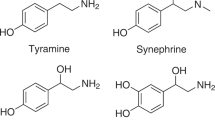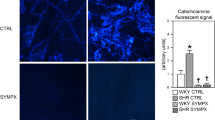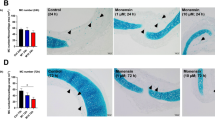Abstract
THE release of histamine after the application of antigen to a sensitized tissue provides a readily measurable index of the occurrence of a cellular anaphylactic reaction, while inhibition of the release in these conditions provides a measure of inhibition of the anaphylactic reaction. Various substances, including metabolic inhibitors, anaesthetics and antipyretics, have been found to inhibit anaphylactic histamine release1; their 50 per cent inhibitory concentrations vary from 2 × 10−5 M to 10−1 M (for example, in the actively sensitized guinea-pig lung it is 10−4 M for iodoacetate and 4 − 10−3 M for phenylbuta-zone). An early finding2 was that adrenaline, as well as inhibiting bronchoconstriction, prevents the release of histamine during the anaphylactic reaction of isolated guinea-pig lung. Large doses of adrenaline (1 rng injected into the perfusate) were used to obtain this effect. It has also been shown3 that isoprenaline inhibits antigen-induced histamine release from actively sensitized human leucocytes, with concentrations of 2–6 × 10−4 M required for 50 per cent inhibition. We have investigated the effect of sympathomimetic amines on antigen-induced histamine release in passively sensitized human lung tissue and found that, in concentrations less than 1/1,000th of those of the most active inhibitors hitherto reported, they can prevent anaphylactic histamine release.
This is a preview of subscription content, access via your institution
Access options
Subscribe to this journal
Receive 51 print issues and online access
$199.00 per year
only $3.90 per issue
Buy this article
- Purchase on Springer Link
- Instant access to full article PDF
Prices may be subject to local taxes which are calculated during checkout
Similar content being viewed by others
References
Mongar, J. L., and Schild, H. O., Physiol. Rev., 42, 226 (1962).
Schild, H. O., Quart. J. Exp. Physiol., 26, 165 (1936).
Lichtenstein, L. M., and Margolis, S., Science, 161, 902 (1968).
Assem, E. S. K., and Schild, H. O., Brit. Med. J., 3, 272 (1968).
Cox, J. S. G., Nature, 216, 1328 (1967).
Assem, E. S. K., and Mongar, J. L., Intern. Arch. Allergy (in the press).
Schild, H. O., Brit. J. Pharmacol., 31, 578 (1967).
Sutherland, E. W., and Robinson, G. A., Pharmacol. Rev., 18, 145 (1966).
Author information
Authors and Affiliations
Rights and permissions
About this article
Cite this article
ASSEM, E., SCHILD, H. Inhibition by Sympathomimetic Amines of Histamine Release induced by Antigen in Passively Sensitized Human Lung. Nature 224, 1028–1029 (1969). https://doi.org/10.1038/2241028a0
Received:
Revised:
Issue Date:
DOI: https://doi.org/10.1038/2241028a0
This article is cited by
-
Regular exercise modulates cardiac mast cell activation in ovariectomized rats
The Journal of Physiological Sciences (2016)
-
Potential anti-anaphylactic activity of clenbuterol, a beta-agonist with calcium antagonist properties
Agents and Actions (1985)
-
Attenuation of antigen-induced bronchospasm by fenoterol in the guinea-pig
Agents and Actions (1984)
Comments
By submitting a comment you agree to abide by our Terms and Community Guidelines. If you find something abusive or that does not comply with our terms or guidelines please flag it as inappropriate.



